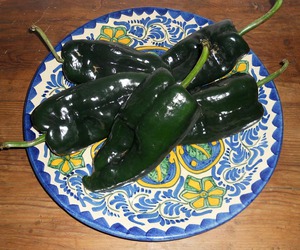Mexican Kitchen

In the enormously diversified world of chiles, the poblano has long been considered one of the tastiest, most attractive and widely used of the capsicum family. A staple of Mexican home and restaurant cooking, the poblano has, in recent years, been fondly adopted into the family of favorite vegetables north of the border.
Although poblano chiles are now available throughout the year, they are truly in season during the summer, when they flood Mexican and foreign markets. Beginning this month, and reaching a peak in August and September, the rainy season harvest yields an abundance of these mild-to-hot, and amazingly versatile, chiles.
Characterized by the thick skin which makes them ideal for stuffing, poblanos were being used in the cuisine of the area around Puebla, for which they are named, when the Spaniards arrived in the sixteenth century. The nuns of the Colonial era were responsible for incorporating poblanos and other chiles into the diet of New Spain. The famous chiles en nogada , generally considered to be Mexico’s national dish, is a classic example of Creole cooking, combining the New World native poblano chile with European filling ingredients. Created in a Puebla convent to honor a visiting archbishop, this central Mexican specialty is indispensible in celebrating Independence Day in September and was, for many years, the traditional comida for the feast of San Agustín in August.
Long before the Spaniards arrived, however, capsicum annuum, the grandaddy of most of the chiles used in Mexican cooking today, thrived in the Tehuacan valley of what is now the state of Puebla. Evidence of its presence there dates from as early as 7200 B.C.
Used to flavor everything from tamales to the corn gruel beverage atole, chiles varied from one part of the Aztec empire to the next. The larger, sweeter texochilli, known today as poblanos, were also smoked and dried, just as they are today, in which case they are known as anchos rather than the Nahuatl pochilli.
Although poblanos have long been cultivated commercially, many people grow them in home gardens. They are particularly rewarding for beginning gardeners, growing quickly and being resistant to many garden pests. Although there are many on-line and mail order sources for chile seeds, they may also be removed from pods at home and left to dry at room temperature for two weeks before being started in small containers. For excellent advice on starting, transplanting, caring for and harvesting chile plants, consult the chile cultivation sources listed at the end of this article.
Whether you grow your own or buy them at your local farmers’ market or produce department, keep in mind that the ideal poblanos are smooth-skinned, triangular, and free of stem punctures and dents. Color is usually dark green, although many people prefer to leave the chiles on the plant until they turn red.
Smoothness of skin is particularly important in recipes calling for roasting and peeling the chiles. In preparing chiles rellenos, the poblanos are roasted over a gas or other open flame until charred on the outside, then left to “sweat” for a few minutes in a plastic bag, making them easy to peel by rubbing away the charred skin or rinsing it off under running water. My book Take This Chile and Stuff It (Golden West Publishers, 1998) provides detailed instructions for peeling and stuffing chiles with a variety of ingredients from cheese to shrimp, with or without batter, prepared in several different ways – from cold, marinated poblanos to oven-baked anchos.
The degree of heat in chiles can be adjusted somewhat when preparing them at home. Soaking in salt water or in a solution of vinegar and water, followed by thorough rinsing, cuts down on the capsaicin, a substance produced in the placenta and found in the seeds and veins, which makes chiles hot.
Although poblanos only rate between 1,000 and 1,500 Scoville units on the chile heat scale (which ranges from zero units for bell peppers to 16, 000 units for pure capsaicin) care should be taken in handling them. Washing hands thoroughly with soap and water, followed by a fresh lemon rub, will rid the skin of most capsaicin residue, as will rubbing hands with sugar before washing. Always remember to clean the knife and cutting board, and to refrain from rubbing your eyes!
Stuffing poblano chiles was a learning experience, a hobby, and finally a commercial venture for me, but there are many other ways of preparing and using them in other dishes. They go particularly well in a variety of cream sauces for meat, chicken and pasta, recipes for which follow. Those wishing to really start from scratch may want to order seeds and/or consult cultivation resources at the following web sites:
For Chile Seeds:
- Jimmy’s Chiles: https://www.jimmyschiles.co
- New Mexico Chiles. https://www.nmcchile.com
Poblano Recipes:
- Chicken in poblano cream Sauce: Pollo poblano
- Beef with poblano chile strips: Res con rajas de chile poblano
- Mexican spaghetti with poblano chile and squash blossom sauce: Espageti al poblano

